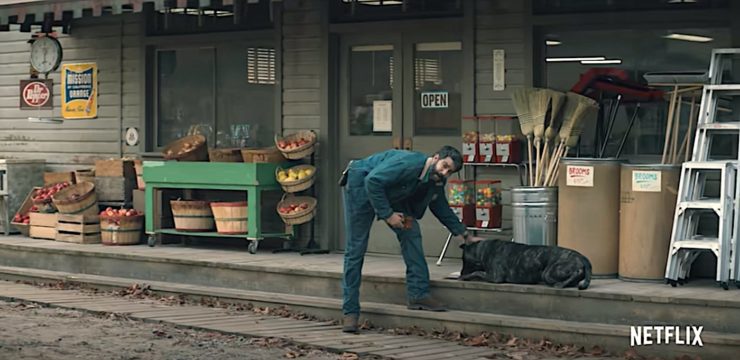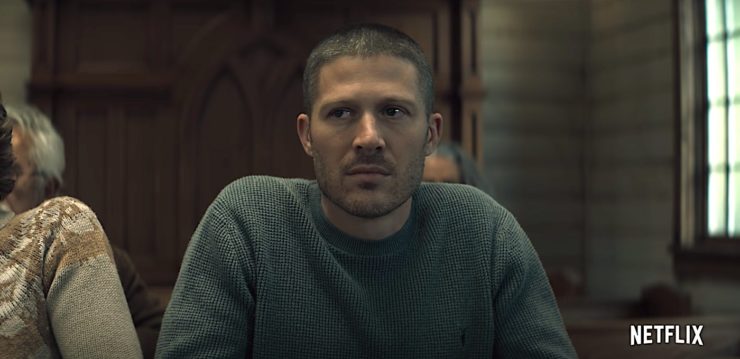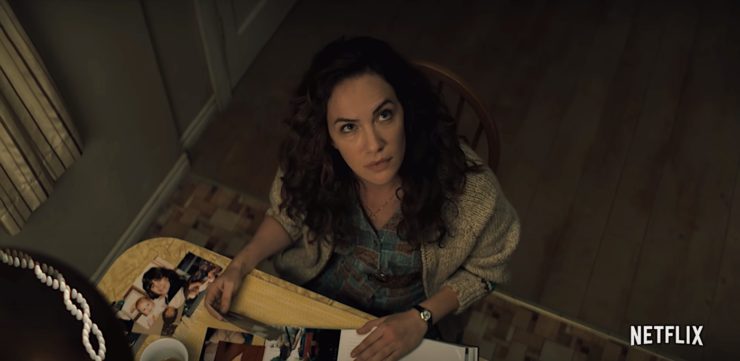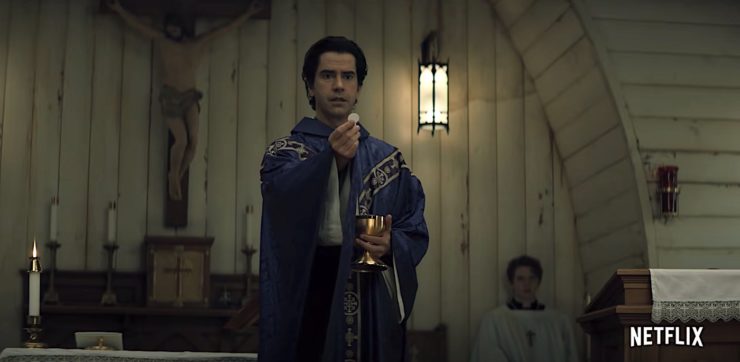Mike Flanagan’s latest horror series is just as traumatizing as his adaptations of Haunting of Hill House and Haunting of Bly Manor. Midnight Mass gives us an isolated, inherently spooky setting, a whole town of troubled folks with secrets, some beautiful, twisting monologues, and more ACTING than I’ve seen all year. This series is a raw, sometimes gory, deeply unsettling take on religious horror.
In some ways it’s better than Flanagan’s previous Netflix outings, but even more than Hill House and Bly Manor, it’s a character study being told through horror. Let me begin by saying that Midnight Mass is beautiful and unique, and I can’t recommend it highly enough. Or, to quote myself from a group text on Friday night: “i’m 40 minutes in on midnight mass and its everything I could ever want.”
Here is some lightly-spoilery blathering about Midnight Mass!
To get this out of the way: You want to go into this show as cold as possible because it’s a wild ride. I watch a lot of horror and I was still honestly surprised by some of the turns this took. This is your last chance to GET OUT OF HERE.
For those of you who are sticking around, Midnight Mass is set in a small fishing community on a remote island. There’s not much money to be made as the Bay is still recovering from an oil spill. The majority of the townsfolk would probably call themselves Catholic, even though only a few attend St. Patrick’s Church (est. 1824) each Sunday. Riley Flynn comes home after a tragedy on the same day that a new priest, Paul Hill, comes to fill in for the ancient Monsignor John Pruitt of St. Patrick’s. Shortly after his arrival, strange (miraculous???) things begin to occur, wreaking havoc on the island.
This show is creepy, slow burn horror with occasional spikes of gore. But behind all the scary stuff is a slow burn character study on the Flynn family, their neighbor Erin Green, town busybody Bev Keane, Father Paul, the mayor’s family, the sheriff’s family, the town doctor—everybody gets some screentime, depth, and nuance. So when shit gets real in episode five, there are stakes. The acting is excellent across the board, but I want to start by saying that Hamish Linklater is mesmerizing as Father Paul. It’s a difficult role because not only is he in a huge amount of the series, he has to balance between being creepy and heartfelt and commanding, and I couldn’t take my eyes off him. Zach Gilford is an open wound as Riley, and quickly became one of my favorite characters of the year. And holy crap did Samantha Sloyan make me hate Beverly Keane.
Paul Hill is a perfect unsettling priest. He seems to be acting from love, but there’s just something… off about him. He’s intense, and at times seems to have an almost pre-Vatican II traditionalist fervor. But he also wears jeans with his collar, and is comfortable telling people at the town’s AA meeting to cut the bullshit. As we learn the truth about him, more and more of his behavior makes sense, but what’s wonderful is that he never becomes a collection of fictional priest tropes—he’s always himself.
In addition to being a perfect spooky Halloween-y show, this is also an early holiday gift for the bisexuals among us.

Rahul Kohli is amazing. We knew he was going to be amazing, but he’s amazing in denim—dad and Daddy in one—and gives a couple of the most heart-wrenching scenes in the show. As with Ben (the Magnificent) Shakir in Evil, we have some excellent Muslim rep here, but unlike Ben, Sheriff Hassan practices and is raising his son in the faith, with all the complications that brings in a small, tight-knit, overwhelmingly Christian community.
Riley Flynn and Erin Green are both classic, complex Flanagan characters who are grounded in detail and difficult life choices. Riley is in recovery, and it’s dealt with extremely well! Erin is the latest in a proud tradition of “Katie Siegel tears your heart out of your chest and makes you love it”!
Yes, there is Nuanced Lesbian Pining!
Yes, Henry Thomas does a cool accent, and also Tears Your Heart Out of Your Chest! Look at that sucker beat in his hand! Hope he puts it back before Katie Siegel shows up again!
The posters in Riley’s room! Se7en, Scream, and Scully! The Stephen Kings and Christopher Pikes on his book shelf!
Joe Collie’s dog is named Pike!
The actual villain of the show is the most deliciously hate-able character I’ve seen in a long time. She’s also a beautiful tribute to some of Stephen King’s most awful bullies. But she never quite descends into caricature—and remains all the more terrifying for that. There’s a scene between her and Sheriff Hassan that might be the scariest thing in all seven episodes. Meanwhile, the monster of the show is used sparingly, and is just as scary the last time you see him as the first.
The show’s episodes are all named for books of the Hebrew Bible and New Testament, and glory hallelujah, they’re all interesting, relevant books. Nobody on Midnight Mass is going to make some sloppy reference to Job and call it a day.

The soundtrack is a mix of Neil Diamond and straightforward hymns! Also great! (Though if you’re going to listen to “Holy, Holy, Holy”, I recommend Sufjan’s version.)
After Haunting of Hill House, Bly Manor, and Doctor Sleep, I’m already all in on Mike Flanagan. His balance of raw emotion, genuinely frightening horror, and the willingness to let his actors act the shit out of long, complex monologues was seemingly engineered in a lab to make me happy. I didn’t quite dig the ending of Hill House, but I thought his adaptation of Shirley Jackson’s work was often incredible. Bly Manor made me sob like a baby, twice. And I think Doctor Sleep is one of the rare King adaptations that encompasses all of what makes him an icon.
Midnight Mass isn’t an adaptation, it’s a Flanagan original. He’s been chewing on the ideas here since 2014, and what’s resulted is a masterfully constructed work—this shit is airtight. Each detail adds up to make the ending inevitable, but you never see his brushwork, all the tiny choices and character flaws work together to create one of the most intense viewing experiences I’ve had since—well, since the finale of Bly Manor.
There’s usually a moment in horror when the book or show tips from “eerie” or “spooky” into what I’ll call normalization. When the audience proxy characters confront the monster, or hear some backstory, or develop a plan to fight it. When the plot kicks in, basically, and it goes from being spooky vibes to a story with a plot and an ending looming on the horizon. For me at least it’s very hard to maintain the initial spookiness, which is what I go to horror for. my go-to example is Sleepy Hollow—what starts as an incredibly atmospheric Halloween watch gradually becomes bound by rules and rituals; the townspeople know the horseman can’t step on sacred ground, they hide in the church, then he uses a fencepost as a makeshift harpoon to snag his quarry. Later, we learn in Scooby Doo-esque detail exactly how he’s being manipulated by dark magic, and his pursuit of the protagonists becomes a long, predictable action sequence as they figure out how to stay ahead of him and work around the spell. Which, I like Sleepy Hollow a lot, and it’s still fun throughout, but it kind of stops being a horror movie for me.
To use a more immediate example: Hill House and Bly Manor each had these points. We learned the mechanics of Hill House to a certain extent; we learned the precise, to-the-minute schedule of the ghosts of Bly Manor. But where Flanagan works well is that his stories are so grounded in character that it doesn’t matter as much once you see the mechanic, because you’re invested in the people living through it. The story of the Bent-Neck Lady is more of a gut-punch once you understand it. “The Romance of Certain Old Clothes” tells you why Bly Manor is haunted, but again, the revelations add such depth and tragedy to the story that they add to it rather than making it feel like clockwork turning.

This series doesn’t quite do that. The monster is never explained. We never have any idea what it is, where it came from, if there are more monsters waiting out there. What MM does instead is shift genre repeatedly across its seven episodes. What begins as a character-driven drama with spooooky horror lurking on the edges turns into a religious horror, then into a straightforward quasi-vampire story, then into a cultish Wicker Man-type situation. And then in the last episode its turns into a straight up giallo-y meatgrinder. But because its Mike Flanagan, it stays grounded in character throughout. You end up with, for instance, a scene where a person is horribly mangled and bleeding out, but also giving a beautiful monologue about love and death. We have to confront the fact of their broken body, and the poetry of their final thoughts. It’s a lot to take in, and I feel like this one wobbled a bit more than Hill House and Bly Manor at times, but if that’s the cost of heightened storytelling I’ll take the wobbles.
Speaking as religion nerd, it felt so good to see Catholicism treated seriously! And to see an accurate depiction of Islam! There’s a scene where Sheriff Hassan explains to a bunch of shocked Christians that Muslims do, in fact, love Jesus, and that the Koran is building on the same faith tradition as Judaism and Christianity, and it’s just… lovely? (I kept hoping someone would burst through the wall like Kool-Aid Man and explain Baha’i while they were at it, but alas, it’s a small island.) And not to be outdone, atheism is beautifully represented! One of the main characters is a non-believer whose ideas about life are just as complex and nuanced as the believers who surround him, and he quickly became my favorite. MM doesn’t shy away from showing how many of the Christians in the community try to grind the non-Christians down, sometimes in horrifically bigoted ways, but it also shows Christian characters completely embodying the ideals of that faith. And I don’t think it’s spoiling anything to say that no viewpoint is shown to be “right”—everyone gets a chance to talk, and the show itself never takes a side.
As in Hill House and Doctor Sleep, Flanagan remains one of our best interpreters of addiction. When Riley mentions needing to go to the mainland, I assumed it was to meet a parole officer, but it isn’t—it’s for weekly AA meetings. He gets his stamp, presumably a copy gets faxed to his parole people, he gets to stay on the outside. He is dedicated to sobriety because of what he did. One of the great knife-twists of the show is that things are only able to escalate because Riley, Erin, Paul Hill, Sheriff Hassan—all of them are trying to get better. All of them want to create new lives, or atone for their pasts. An attempt to do good in the world is subverted and made horrific. And what’s great about Flanagan, again, is that you can both see the beautiful impulse of this, and also see that it’s doomed because Father Paul is in the grip of a terrifying… but wait, that would spoil some stuff.
I’ll stop here for now, and tell you that if you love horror, there are a lot of references and deep cuts here for you to enjoy in addition to just being properly freaked out a lot. And if you love character-driven drama (with a side order of grappling with death!) this is your show.
Leah Schnelbach has a LOT more to say about this show. Come confess your thoughts them on Twitter!










